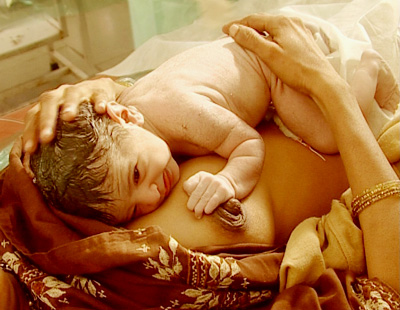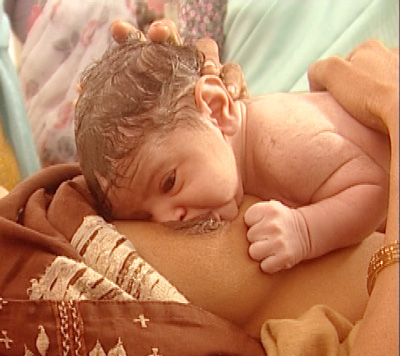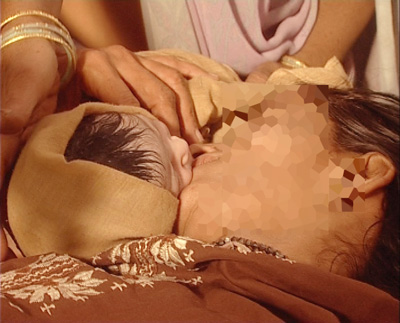
- We have neither heard of nor seen this happen before. How did you discover the 'Breast Crawl'?
- If the Breast Crawl is evidence based, why is it not being practised?
- In many places, if initiation is not being practised by the Breast Crawl or a similar process, how is it practised?
- What advantages does early initiation offer? How is the 'Breast Crawl' superior to other patterns of initiation in terms of getting these advantages?
- Do all babies move like this? We would like to try this in our maternity service. Can you give us some tips?
- What is the significance of 'cheek to cheek contact' shown in the video?
- Why make the baby go through the entire process of breast crawl? It might be logical to help the baby to take the first breastfeed as soon as it shows readiness to suckle.
ensure successful establishment of breastfeeding?
- Have you tried the Breast Crawl with premature or low birth weight (LBW) babies? What are the contraindications?
- Is the 'Breast Crawl' possible if the baby is born by Caesarean Delivery?
- There are many people around the mother in this video. Is it right?
 2.1 We have neither heard of nor seen this happen before. How did you discover the 'Breast Crawl'?
2.1 We have neither heard of nor seen this happen before. How did you discover the 'Breast Crawl'?
We have been aware of scientific articles describing this phenomenon for many years. About two years ago (2005), we read about the 'Breast Crawl' in a textbook of neonatology 'Care of the High-Risk Neonate' by Dr. Marshall Klaus and Dr. Avroy Fanaroff. It was the first time that we found 'a textbook' recommending 'Breast Crawl' as a method to initiate breastfeeding. The vivid description and good scientific explanation influenced us greatly. The Breast Crawl was originally described in 1987 by Dr. Ann-Marie Widström, Dr. Anna-Berit Ransjo-Arvidson, Dr. Kyllike Christensson, Ms. Ann-Sofi Matthiesen, Dr. Jan Winberg and Dr. Kerstin Uvnäs-Moberg from Karolinska Institute (Sweden).
The recommendation was discussed with Obstetricians Rachna and Kartik Bhagat, who readily agreed to try it out at their maternity service 'Grace Maternity & Nursing Home' at Kandivali (Mumbai). The Breast Crawl was seen exactly as described in the textbook. It was a thrilling experience not only for the parents but for the entire staff, who felt that they had witnessed a miracle. The Breast Crawl generated such excitement and motivation that the method continued to be used routinely. This was in sharp contrast to the great efforts that were required to introduce any new routines in the past. The Breast Crawl seemed to be the best and easiest method to implement the recommendation to 'Initiate breastfeeding within an hour of birth' (4th Step). We were convinced that the Breast Crawl had tremendous potential to change initiation practices.
Subsequently, BPNI Maharashtra adopted the Breast Crawl as a recommended method for the initiation of breastfeeding. The demonstration of the Breast Crawl became a part of our 3 day IYCF Workshops. A video recording done during a workshop at Nandurbar (Maharashtra) in December 2005 was subsequently used for a one day-sensitization programme of grass-root health workers, advocacy to senior government officers and pre-delivery counselling sessions for pregnant mothers. The response everywhere was overwhelming.
This motivated us to convert the video clip into a documentary. We felt that the Breast Crawl deserved world wide dissemination for improving initiation rates, breastfeeding success and ultimately reducing neonatal, infant and under-five morbidity and mortality.


 2.2 If the Breast Crawl is evidence based, why is it not being practised?
2.2 If the Breast Crawl is evidence based, why is it not being practised?
Many health personnel in maternity services are probably not aware of implementing the recommendation to 'Initiate breastfeeding within an hour of birth'. Routines and procedures established on the grounds of efficiency or for supposed scientific reasons may also interfere. As a result, the initiation of breastfeeding is often delayed. In these circumstances, awareness and practice of the Breast Crawl is next to impossible.
Even in those places where health professionals are well informed and keen to initiate breastfeeding within an hour of birth, awareness of the Breast Crawl is lacking. Few textbooks, other than the book by Dr. Klaus, mention this phenomenon or vividly describe the techniques of initiation. The Breast Crawl is not a part of standard medical or health curriculum.
WHO and UNICEF
BFHI documents that recommend initiating breastfeeding within an hour of birth subtly describe the process of the 'Breast Crawl'. However, a precise method needs to be described with clarity. The Breast Crawl will bridge this gap and strengthen the recommendation.
Even in accredited 'Baby Friendly' maternity services; the 4th Step is not often being practised in its true spirit. It is thought to be met as long as the baby is put to the breast within an hour of birth, irrespective of the duration and the extent of skin-to-skin contact and the duration of the first breastfeed. Liberty is also taken by maternity services to extend the 'an hour' limit to 'half to one hour' or 'one hour' (supported by literature at places).
However, a few places do initiate breastfeeding by the 'Breast Crawl' or by a similar process which amounts to the 'Breast Crawl', without giving it this label.

 2.3 In many places, if initiation is not being practised by the Breast Crawl or a similar process, how is it practised?
2.3 In many places, if initiation is not being practised by the Breast Crawl or a similar process, how is it practised?
To understand this, we need to know various routines which may be practised before or soon after delivery (birthing practices). Some routines are necessary, some must be delayed and some are not recommended anymore.
For Mother:
- Drugs for pain relief
- Episiotomy: a small incision to widen the vaginal outlet which needs to be sutured immediately after birth.
- Moving mother out of the labour room
For Baby:
- Oropharyngeal suction
- Drying the baby thoroughly
- Clamping the cord
- Weighing
- Passing the orogastric tube to empty the stomach contents
- Injection of vitamin K
- Baby bath
- Wrapping the baby (dressing)
Most of these labour room routines hamper the first natural contact between the baby and the mother. Section 2.5 discusses the guidelines.
Most of the time, the baby is given to the mother in the labour room itself or in the ward, already wrapped up, for her to feed in the sitting or sleeping position (turned on one side).
Naked skin-to-skin contact between the baby and the mother may be partial or absent. The period of skin-to-skin contact and suckling (first breastfeed) is also extremely variable.

 2.4 What advantages does early initiation offer? How is the 'Breast Crawl' superior to other patterns of initiation in terms of getting these advantages?
2.4 What advantages does early initiation offer? How is the 'Breast Crawl' superior to other patterns of initiation in terms of getting these advantages?
Early initiation offers several advantages to the baby and the mother.
- Helps to keep the baby warm
- Leads to faster and effective achievement of feeding skills by the baby
- The baby starts getting colostrum as the first feed. Colostrum has high concentration of antibodies (immunity). Baby starts getting colonized by safe germs (bacterial flora) from the mother. Both these offer protection against infections and hence are important for the baby's survival.
- Helps uterine contraction, faster expulsion of the placenta, reduces maternal blood loss and prevents anaemia.
- Leads to better sugar levels and other biochemical parameters in the first few hours of birth.
- Earlier passage of meconium (first blackish-green stool) and hence decreased intensity of normal (physiological) newborn jaundice.
- Early and long term breastfeeding success.
- Better mother-infant bonding.
- May have a role in boosting development of baby's nervous system.
There is evidence that many of these are better achieved with the Breast Crawl, which also offers proper acclimatization from the intrauterine to the extrauterine environment. This is also a natural instinctive process with other mammals. Hence, the maximum benefits of early initiation are best achieved with the Breast Crawl.

 2.5
Do all babies move like this? We would like to try this in our maternity service. Can you give us some tips?
2.5
Do all babies move like this? We would like to try this in our maternity service. Can you give us some tips?
The Breast Crawl is natural and instinctive. A majority of babies would reach the breast all by themselves and start suckling spontaneously. The technique has been shown in the accompanying video. This is simple, easily replicable and does not require a complex learning process by the staff.
To achieve optimal results
- Discuss the Breast Crawl during Pre-delivery counselling sessions. Tell the mother about the need to wear clothes that make skin-to-skin contact possible.
- Orient staff to the technique.
- Use drugs for labour analgesia judiciously.
- A baby who has cried well does not need oro-nasal suction.
- Dry the baby thoroughly except for the hands
- Baby bath is best delayed beyond 24 hours.
- Do not pass orogastric / nasogastric tube or do gastric suction as a routine for the baby.
- Delay Injection vitamin K, weighing, routine measuring and dressing (wrapping) of the baby till after the first breastfeed
- The baby and the mother should be covered together with a cloth, so that they keep warm while continuing with skin to skin contact.
- Raise mother's head on a pillow to facilitate mother-baby visual contact.
Do not wash / wipe breast before feeding.
- Continue the first skin-to-skin contact, until completion of the first breastfeed.
- Most babies would finish the Breast Crawl in 30-60 minutes. Hence, if a baby has already been in skin-to-skin contact for an hour or more, and has not reached the breast, or has tried to attach several times and has not succeeded, then it can be gently moved nearer to the breast and helped to attach.
- Do not move the mother out of labour room until completion of the first breastfeed.
- The child's father or a close female relative should be a part of this entire emotional interaction. However, if this is not possible at the outset, then they should be called in at the earliest feasible and acceptable time.

 2.6 What is the significance of 'cheek to cheek contact' shown in the video?
2.6 What is the significance of 'cheek to cheek contact' shown in the video?

We are promoting this natural instinct because mothers want to see and touch the baby at a very close distance (as much as the baby needs to see mother's face). They also show a desire to kiss the baby. In India there is also a custom of a mother saying a holy message in baby's ears (practised in some communities). To facilitate all this, we discovered 'cheek to cheek contact'. All mothers enjoy these early moments. Many become extremely emotional, some burst out crying with joy and some have even licked their babies. (In a fashion similar to what a cow would do to a calf.) After allowing this interaction we place the baby in a position to do the Breast Crawl. Cheek to cheek contact is not a substitute for full skin-to-skin contact.

 2.7 Why make the baby go through the entire process of breast crawl? It might be logical to help the baby to take the first breastfeed as soon as it shows readiness to suckle.
2.7 Why make the baby go through the entire process of breast crawl? It might be logical to help the baby to take the first breastfeed as soon as it shows readiness to suckle.
Mother-baby interactions at any time are not restricted to nutritional needs alone. The transition from the intrauterine to the extrauterine environment is made most comfortable by the Breast Crawl. Initiating early skin to skin contact offers many advantages which have been listed. Hence, focussing on the initiation of suckling alone is not justified.
Should the Breast Crawl be interrupted when a baby shows readiness to suckle? Will it be appropriate at this juncture to help the baby to attach? This needs further discussion and research. However, we feel that interrupting a natural instinctive process may not be beneficial. Continuing with the process, may provide early optimal natural stimulation to the various sensory organs and the brain. This may offer an advantage for better sensory-neural development. The baby reaches out to the nipple in a massaging movement. This not only protracts the nipple and makes it more prominent, but also releases a hormone called oxytocin. This helps the first breastfeed.

 2.8 If the baby has successfully completed the Breast Crawl and taken the first breastfeed, does it ensure successful establishment of breastfeeding?
2.8 If the baby has successfully completed the Breast Crawl and taken the first breastfeed, does it ensure successful establishment of breastfeeding?
The Breast Crawl is a wonderful method to initiate breastfeeding. Proper initiation does not necessarily mean successful establishment of breastfeeding. It is the first giant step, no doubt, of a process which ultimately ends with establishment of lactation in a few days.
In this period mothers need to recognize and respond to early infant feeding cues and confirm that the baby is being fed at least 8 times in each 24 hours. Frequency of feeding and skin-to-skin contact is the key to success. Rooming-in, demand feeding, proper techniques of attachment, positioning and expression of breastmilk coupled with appropriate support to the mother is crucial to establishment of successful lactation.

 2.9 Have you tried the Breast Crawl with premature or low birth weight (LBW) babies? What are the contraindications?
2.9 Have you tried the Breast Crawl with premature or low birth weight (LBW) babies? What are the contraindications?
If the preterm / LBW baby does not have respiratory distress, the baby may Breast Crawl. However, contact time may be limited in babies needing transfer to the premature / intensive care unit care. At this juncture, if the baby is showing readiness to suckle, we help it take the first breastfeed. Those babies not needing a transfer continue the Breast Crawl. Most babies complete it successfully. However, we do not have exact figures. We have not come across a study published on this subject.
Respiratory distress can be considered as a contraindication for the Breast Crawl. Even in these cases we ensure that the baby is shown to the mother and she is encouraged to kiss, touch and cuddle the baby before transfer.

 2.10
Is the 'Breast Crawl' possible if the baby is born by Caesarean Delivery?
2.10
Is the 'Breast Crawl' possible if the baby is born by Caesarean Delivery?
The standard Breast Crawl is obviously not possible in caesarean deliveries. However, since the majority of caesarean sections are now performed under spinal anaesthesia, the mother is fully conscious. The baby is shown to the mother and given to her for 'cheek to cheek contact'.
The baby is then placed on the mother's chest from the head end, by the side of the anaesthesiologist, even while the surgery is going on. The mother requires help in positioning and holding the baby. We assist the baby in attaching to her mother's breast as soon as she shows a readiness to suckle, allowing the first breastfeed for as long as feasible in the operation theatre itself.
If the mother or the baby's condition does not permit this, the baby is given to the mother at the earliest opportunity. There are no specific observations as yet or nothing to recommend in particular.

 2.11 There are many people around the mother in this video. Is it right?
2.11 There are many people around the mother in this video. Is it right?
Delivery and first contact are times during which a mother and infant need privacy. Hence, nobody apart from the minimum necessary health personnel, the child's father and / or a close female relative should be present in these emotional and private moments.
The video was taken during one of our training workshops conducted for 30 delegates. We had allowed a few participants in the labour room, to learn the technique of Breast Crawl. The issue was discussed earlier with the mother and her family.

